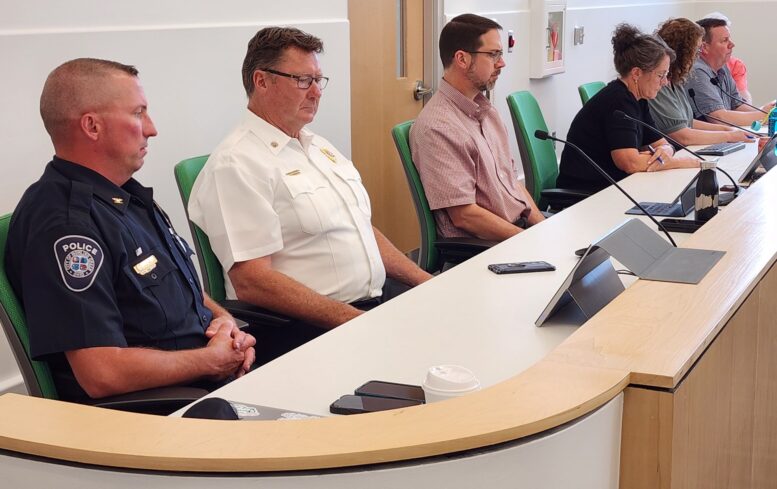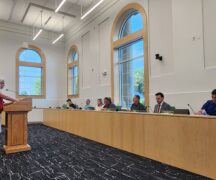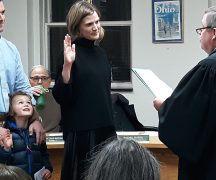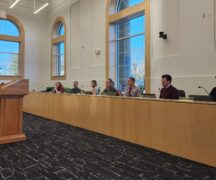By JAN McLAUGHLIN
BG Independent News
Bowling Green residents may be asked in November to pass an income tax increase to help pay for two new fire stations and fire equipment.
After years of discussion on the condition of the Bowling Green Police Station, the Court Street Fire Station, and the desire to decrease emergency response time in the city, a proposal was presented to the Council Committee of the Whole Thursday evening.
Municipal Administrator Lori Tretter and Finance Director Dana Pinkert presented a plan addressing the fire station needs first and putting the police station needs on a temporary pause.
Based on the increase in fire and EMS calls, and the unsafe conditions at the Court Street Fire Station, the following recommendations were made:
- Two new stations will be constructed, and the Pearl Street Station will remain in operation.
- A station with administrative headquarters will be built somewhere in the north end of the city, in the area between Haskins and Main streets, and Newton and Van Camp roads. Negotiations are still going on between the city and the landowner, Tretter said. That station will be larger, at an estimated 20,944 square feet.
- A satellite station will be built in the southeast area of the city, on property already owned by the city at Carter Park. Tretter stressed that all the recreation uses will remain in the park, with the disc golf course possibly needing to be reconfigured. This satellite station will be an estimated 14,215 square feet.
- The predicted cost of building and equipping the two new stations will be in the ballpark of $30 million. That includes $14.7 million for the headquarter station, $10.5 for the satellite station, $2.5 million for an aerial ladder truck, and $2 million for other fire and ambulance equipment.
The police station is also in dire need of improvements in its 130-year-old building downtown. Not only is the space difficult to use for a modern police operation, it’s also not user-friendly for the public.
Council member Joel O’Dorisio asked if city officials had considered building a new police station rather than trying to turn the old structure into usable space. Both Tretter and Mayor Mike Aspacher voiced commitment to the current site.
“We understand the community values this historic structure,” Tretter said.
“It was considered,” Aspacher said of a new site. “But we remain committed to being in the downtown.”
While the building presents challenges, “we can renovate that building so it can serve a modern police department,” the mayor added.
City officials asked that the police station renovations be revisited, with no definite decisions being made now. It was suggested that the police renovations be paid for with city capital improvement funds.
Pinkert explained a proposal to change the long-standing process of how the existing income tax is distributed among city departments. She suggested 0.15% of the existing 0.3% income tax collection go from the water/sewer capital fund into a capital improvement fund and street repair fund.
But that will only pay a portion of the costs for the new fire stations. So Pinkert also recommended that City Council place a 0.15% income tax increase on the November ballot.
Utilities Director Brian O’Connell explained that to make up for the capital improvement money taken from the water and sewer funds, those rates will need to be increased to collect about $1.5 million annually.
The average residential customer in Bowling Green would see their monthly water bill go up 70 cents, and their monthly sewer bill go up by $1.10 a month, O’Connell said.
Even with the increases, Bowling Green residential bills will be lower than many in the region, he said. Currently, the total monthly water and sewer bill for a residential customer in Bowling Green is $36.95, compared to $54.13 in Findlay, $93.10 in Perrysburg, $107.08 in Defiance, $136.25 in Maumee, and $147.45 in Napoleon.
That will be up to the BG Board of Public Utilities to set any rate increases.
But it is up to City Council to put an income tax on the ballot. The filing deadline to get on the ballot is Aug. 6, and council is required to have three readings of such resolutions – so the first reading will come on Monday evening.
If the income tax passes, construction would begin in 2026, Tretter said.
After the presentation, Aspacher let council know his feelings on the issue.
“I fully support the recommendations made this evening,” he said, calling the proposal “a positive solution to complex community challenges.”
While city officials don’t take it lightly to ask for citizens to pay more taxes, “we all feel a responsibility for the health and safety of our residents,” Aspacher said.
Response times of four minutes or less anywhere in the city is the goal.
“It is achievable with this model,” he said.
Council member Bill Herald complimented city administration proposing a plan.
“You’ve shown leadership in trying to move the city forward,” he said.
Tretter said that a report in December on the unsafe conditions at the Court Street fire station was a “wake-up call” to the city.
Following are some of the factors under consideration:
- Staff has doubled since the Court Street station was built in 1984.
- That station was built for an all-male workforce.
- Vehicles are much larger. Soon, new fire engines will not fit inside the bays.
- New fire stations are now generally limited to one story to speed response and meet ADA guidelines.
- Fire stations are now designed with multiple zones and air exchange to reduce exposure to carcinogens.
Plus as the city grows, the demands increase. But response times cannot, if the city wants to provide best chances of survival for people and property.
The number of fire and EMS calls have tripled, from 1,095 calls for service in 1992, to 3,418 calls in 2022. The number is expected to hit 4,000 this year.
While demands on the police division also grow, the space they have to operate in is pretty set in stone. Calls for service have doubled from approximately 15,000 in 1984, to 30,000 in 2024. In that same period, the number of officers has gone from 28 to 42, and the number of dispatchers has grown from nine to 11.
Architects identified the following shortcomings of the current police station:
- Security – Facility does not provide the current recommended layered security separation/isolation strategies for a modern police headquarters.
- Transparency and engagement – Public engagement and a transparent image for the police station is not possible in the current setting.
- Disjointed operational configuration – Individual units are spread out across the building, on multiple floors, reducing efficiency of daily operations and effectiveness of staff.
- Evidence processing and storage – Evidence processing areas lack the appropriate equipment and functional spaces to address the increased demands of these operations.
- Firing range – Range lacks appropriate ballistic and HVAC filtration systems, creating health and safety risks.





